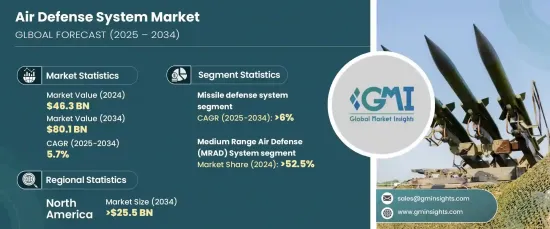
|
시장보고서
상품코드
1667163
세계의 방공 시스템 시장 : 기회, 성장 촉진요인, 산업 동향 분석 및 예측(2025-2034년)Air Defense System Market Opportunity, Growth Drivers, Industry Trend Analysis, and Forecast 2025 - 2034 |
||||||
세계의 방공 시스템 시장은 2024년 463억 달러였고, 첨단 방위 기술에 대한 수요의 급증을 반영해, 2025년부터 2034년까지 CAGR 5.7%를 나타낼 것으로 예측됩니다.
세계 각국은 통합 방공 시스템(IADS)의 배치를 우선하고 있으며, 이 산업의 현저한 성장을 견인하고 있습니다. 이러한 최첨단 시스템은 스텔스 항공기, 극초음속 미사일, 무인 항공기(UAV) 등 폭넓은 위협에 대항할 수 있는 통합 네트워크에 레이더, 센서, 무기를 통합한 것입니다. 공중 위협의 진화가 보다 복잡하고 예측 불가능해짐에 따라, 각국 정부는 적대적인 전진을 정확하게 감지, 요격, 무력화하도록 설계된 고급 방공 솔루션에 많은 투자를 하고 있습니다. 각국은 드론 무리, 극초음속무기, 전자전 등 새로운 과제에 대한 방위능력 강화를 목표로 시장은 기술 혁신에 추진된 변화를 목격하고 있습니다.

인공지능, 머신러닝, 자율기능은 최신의 방공시스템에 필수적이 되고 있으며, 고도화하는 공중으로부터의 위협에 대처하는 능력을 높이고 있습니다. 다층적이고 네트워킹된 솔루션은 실시간으로 위협을 감지하고 무력화하기 위한 강력한 접근 방식으로 부상하고 있습니다. 에너지 기반 무기 및 고급 대 드론 시스템과 같은 혁신은 고속으로 이동하고 시인성이 낮은 대상에 대항하는 실용적이고 효과적인 수단을 제공합니다.
| 시장 범위 | |
|---|---|
| 시작연도 | 2024년 |
| 예측연도 | 2025-2034년 |
| 시작금액 | 463억 달러 |
| 예측 금액 | 801억 달러 |
| CAGR | 5.7% |
사거리에 따라 시장은 장거리 방공(LRAD) 시스템, 중거리 방공(MRAD) 시스템, 단거리 방공(SHORAD) 시스템으로 구분됩니다. 2024년에는 MRAD 분야가 52.5% 이상의 시장 점유율을 차지했으며 강력한 성장이 전망되고 있습니다. 군은 통합 방어 네트워크를 구축하기 위해 MRAD 시스템을 하늘, 육지, 바다 플랫폼과 통합합니다. 이 통합은 위협 감지, 상황 인식 및 대응 효율성을 향상시킵니다. 주목할만한 것은 폴란드 군이 2023년 6월에 Wisla MRAD 시스템의 첫 번째 포대를 수령한 것으로 중거리 솔루션에 대한 세계의 뒷받침을 반영하고 있습니다. MRAD 시스템의 레이더와 센서 기술의 강화를 통해 저공 비행하는 미사일과 고속으로 이동하는 드론을 보다 정확하게 추적할 수 있어 채용이 더욱 진행되고 있습니다.
유형별로는 미사일 방어 시스템, 대공 시스템, 대 로켓, 대포 및 박격포(C-RAM) 시스템이 있습니다. 미사일 방어 시스템 분야는 2034년까지 연평균 복합 성장률(CAGR) 6% 이상의 성장이 전망되고 있습니다. 이 시스템은 레이더, 적외선 센서 및 위성 네트워크를 활용하여 탄도 미사일과 초음속 미사일의 감지와 요격을 강화합니다. THAAD, 이지스함, 아이언 돔 등의 기술을 조합한 중층적인 방어 접근법이 개발되어, 위협을 비행의 여러 단계에서 요격하여 신뢰성과 유효성을 대폭 향상시키고 있습니다.
북미는 방공 시스템 시장을 선도하고 있으며, 미국은 2034년까지 255억 달러 이상에 달할 것으로 예측됩니다. 이 지역의 이점은 극초음속 미사일과 고속 공중 위협에 대한 방어에 많은 투자를 하고 있기 때문입니다. 미군은 우주 기반 감시를 최첨단 레이더 기술과 통합하여 그 능력을 향상시키고 있습니다. 하늘, 육지, 바다 작전을 위한 상호 운용 가능한 시스템을 구축하는 노력은 세계 시장에서 북미의 리더십을 더욱 견고하게 만들고 있습니다.
목차
제1장 조사 방법과 조사 범위
- 시장 범위와 정의
- 기본 추정과 계산
- 예측 계산
- 데이터 소스
- 1차
- 2차
- 유료소스
- 공적소스
제2장 주요 요약
제3장 업계 인사이트
- 업계 생태계 분석
- 밸류체인에 영향을 주는 요인
- 이익률 분석
- 변혁
- 미래의 전망
- 제조업체
- 유통업체
- 공급자의 상황
- 이익률 분석
- 주요 뉴스와 대처
- 규제 상황
- 영향요인
- 성장 촉진요인
- 방공 시스템의 디지털화의 진전
- 지역 분쟁과 안보 우려 증가
- 극초음속 미사일 개발과 확산 증가
- 보다 우수한 감지, 추적, 요격을 위한 AI, 머신러닝, 자율 시스템의 채용
- 세계 방위 예산 증가
- 업계의 잠재적 리스크 및 과제
- 높은 개발 및 유지 비용
- 최신 방공 시스템을 기존 인프라와 통합할 때의 복잡성
- 성장 촉진요인
- 성장 가능성 분석
- Porter's Five Forces 분석
- PESTEL 분석
제4장 경쟁 구도
- 소개
- 기업의 시장 점유율 분석
- 경쟁 포지셔닝 매트릭스
- 전략 전망 매트릭스
제5장 시장 추계 및 예측 : 컴포넌트별, 2021-2034년
- 주요 동향
- 무기 시스템
- 포탑 시스템
- 20mm
- 23mm
- 25mm
- 30mm
- 35mm
- 미사일 발사장치
- 포탑 시스템
- 화기관제 시스템
- 방공 레이더
- 화기관제 레이더
- i/J 밴드
- X 밴드
- C 밴드
- 감시 레이더
- X 밴드
- C 밴드
- D/L 밴드
- S 밴드
- 화기관제 레이더
- 전기 광학 센서와 레이저 거리계
- 방공 레이더
- 명령 제어 시스템
- 기타
제6장 시장 추계 및 예측 : 사거리별, 2021-2034년
- 주요 동향
- 장거리 방공(LRAD) 시스템
- 중거리 방공(MRAD) 시스템
- 단거리 방공(ShoRAD) 시스템
제7장 시장 추계 및 예측 : 플랫폼별, 2021-2034년
- 주요 동향
- 육상
- 차량형
- 휴대형(맨패즈)
- 해상
- 공중
제8장 시장 추계 및 예측 : 유형별, 2021-2034년
- 주요 동향
- 미사일 방어 시스템
- 대공 시스템
- 대 로켓, 대포 및 박격포(C-RAM) 시스템
제9장 시장 추계 및 예측 : 지역별, 2021-2034년
- 주요 동향
- 북미
- 미국
- 캐나다
- 유럽
- 영국
- 독일
- 프랑스
- 이탈리아
- 스페인
- 러시아
- 아시아태평양
- 중국
- 인도
- 일본
- 한국
- 호주
- 라틴아메리카
- 브라질
- 멕시코
- 중동 및 아프리카
- 남아프리카
- 사우디아라비아
- 아랍에미리트(UAE)
제10장 기업 프로파일
- BAE Systems
- Bharat Dynamics
- Boeing
- General Dynamics
- 한화시스템
- Harris Technologies
- Israel Aerospace Industries
- Leonardo
- Lockheed Martin
- Northrop Grumman
- Rafael Advanced Defense Systems
- Rheinmetall
- RTX
- Saab
- Thales
The Global Air Defense System Market, valued at USD 46.3 billion in 2024, is set to grow at a CAGR of 5.7% from 2025 to 2034, reflecting a surge in demand for advanced defense technologies. Nations worldwide are prioritizing the deployment of Integrated Air Defense Systems (IADS), driving significant growth in this industry. These cutting-edge systems integrate radar, sensors, and weapons into a unified network capable of countering a wide range of threats, including stealth aircraft, hypersonic missiles, and unmanned aerial vehicles (UAVs). With the evolution of aerial threats becoming more complex and unpredictable, governments are investing heavily in sophisticated air defense solutions designed to detect, intercept, and neutralize adversarial advances with precision. The market is witnessing a transformation fueled by innovation as countries aim to bolster their defense capabilities against emerging challenges like drone swarms, hypersonic weaponry, and electronic warfare.

Artificial intelligence, machine learning, and autonomous capabilities are becoming integral to modern air defense systems, enhancing their ability to address increasingly sophisticated aerial threats. Multi-layered, networked solutions are emerging as the go-to approach for real-time detection and neutralization of threats. Innovations like energy-based weapons and advanced anti-drone systems are offering practical, effective means to counter fast-moving, low-visibility targets.
| Market Scope | |
|---|---|
| Start Year | 2024 |
| Forecast Year | 2025-2034 |
| Start Value | $46.3 billion |
| Forecast Value | $80.1 billion |
| CAGR | 5.7% |
Based on range, the market is segmented into Long Range Air Defense (LRAD) Systems, Medium Range Air Defense (MRAD) Systems, and Short Range Air Defense (SHORAD) Systems. In 2024, the MRAD segment dominated with a market share exceeding 52.5% and is poised for robust growth. Military forces are integrating MRAD systems with air, land, and sea platforms to establish unified defense networks. This integration improves threat detection, situational awareness, and response efficiency. Notably, Poland's Armed Forces received their first battery of the Wisla MRAD system in June 2023, reflecting the global push for medium-range solutions. Enhanced radar and sensor technologies in MRAD systems now enable more accurate tracking of low-flying missiles and fast-moving drones, further driving their adoption.
By type, the market includes missile defense systems, anti-aircraft systems, and Counter Rocket, Artillery, and Mortar (C-RAM) systems. The missile defense system segment is expected to grow at a CAGR exceeding 6% through 2034. These systems utilize radar, infrared sensors, and satellite networks to enhance the detection and interception of ballistic and hypersonic missiles. Layered defense approaches, combining technologies like THAAD, Aegis, and Iron Dome, are being developed to intercept threats at multiple stages of flight, significantly improving reliability and efficacy.
North America leads the air defense system market, with the United States projected to surpass USD 25.5 billion by 2034. The region's dominance stems from substantial investments in defending against hypersonic missiles and high-speed aerial threats. US military forces are advancing their capabilities by integrating space-based surveillance with cutting-edge radar technologies. Efforts to create interoperable systems for air, land, and sea operations further solidify North America's leadership in the global market.
Table of Contents
Chapter 1 Methodology & Scope
- 1.1 Market scope & definitions
- 1.2 Base estimates & calculations
- 1.3 Forecast calculations
- 1.4 Data sources
- 1.4.1 Primary
- 1.4.2 Secondary
- 1.4.2.1 Paid sources
- 1.4.2.2 Public sources
Chapter 2 Executive Summary
- 2.1 Industry synopsis, 2021-2034
Chapter 3 Industry Insights
- 3.1 Industry ecosystem analysis
- 3.1.1 Factor affecting the value chain
- 3.1.2 Profit margin analysis
- 3.1.3 Disruptions
- 3.1.4 Future outlook
- 3.1.5 Manufacturers
- 3.1.6 Distributors
- 3.2 Supplier landscape
- 3.3 Profit margin analysis
- 3.4 Key news & initiatives
- 3.5 Regulatory landscape
- 3.6 Impact forces
- 3.6.1 Growth drivers
- 3.6.1.1 Increasing digitalization of air defense systems
- 3.6.1.2 Growing regional conflicts and security concerns
- 3.6.1.3 Rising development and proliferation of hypersonic missiles
- 3.6.1.4 Adoption of AI, machine learning, and autonomous systems for better detection, tracking, and interception
- 3.6.1.5 Rising defense budgets across the globe
- 3.6.2 Industry pitfalls & challenges
- 3.6.2.1 High costs of development and maintenance
- 3.6.2.2 Complexity in Integrating modern air defense systems with existing infrastructure
- 3.6.1 Growth drivers
- 3.7 Growth potential analysis
- 3.8 Porter’s analysis
- 3.9 PESTEL analysis
Chapter 4 Competitive Landscape, 2024
- 4.1 Introduction
- 4.2 Company market share analysis
- 4.3 Competitive positioning matrix
- 4.4 Strategic outlook matrix
Chapter 5 Market Estimates & Forecast, By Component, 2021-2034 (USD Million)
- 5.1 Key trends
- 5.2 Weapon system
- 5.2.1 Gun/Turret system
- 5.2.1.1 20 mm
- 5.2.1.2 23 mm
- 5.2.1.3 25 mm
- 5.2.1.4 30 mm
- 5.2.1.5 35 mm
- 5.2.2 Missile launcher
- 5.2.1 Gun/Turret system
- 5.3 Fire control system
- 5.3.1 Air defense radar
- 5.3.1.1 Fire control radar
- 5.3.1.1.1 I/J-Band
- 5.3.1.1.2 X-Band
- 5.3.1.1.3 C-Band
- 5.3.1.2 Surveillance radar
- 5.3.1.2.1 X-Band
- 5.3.1.2.2 C-Band
- 5.3.1.2.3 D/L-Band
- 5.3.1.2.4 S-Band
- 5.3.1.1 Fire control radar
- 5.3.2 Electro-Optic sensor and laser range finder
- 5.3.1 Air defense radar
- 5.4 Command and control system
- 5.5 Others
Chapter 6 Market Estimates & Forecast, By Range, 2021-2034 (USD Million)
- 6.1 Key trends
- 6.2 Long Range Air Defense (LRAD) System
- 6.3 Medium Range Air Defense (MRAD) System
- 6.4 Short Range Air Defense (ShoRAD) System
Chapter 7 Market Estimates & Forecast, By Platform, 2021-2034 (USD Million)
- 7.1 Key trends
- 7.2 Land
- 7.2.1 Vehicular
- 7.2.2 Portable (Manpads)
- 7.3 Naval
- 7.4 Airborne
Chapter 8 Market Estimates & Forecast, By Type, 2021-2034 (USD Million)
- 8.1 Key trends
- 8.2 Missile defense system
- 8.3 Anti-Aircraft system
- 8.4 Counter Rocket, Artillery, and Mortar (C-RAM) System
Chapter 9 Market Estimates & Forecast, By Region, 2021-2034 (USD Million)
- 9.1 Key trends
- 9.2 North America
- 9.2.1 U.S.
- 9.2.2 Canada
- 9.3 Europe
- 9.3.1 UK
- 9.3.2 Germany
- 9.3.3 France
- 9.3.4 Italy
- 9.3.5 Spain
- 9.3.6 Russia
- 9.4 Asia Pacific
- 9.4.1 China
- 9.4.2 India
- 9.4.3 Japan
- 9.4.4 South Korea
- 9.4.5 Australia
- 9.5 Latin America
- 9.5.1 Brazil
- 9.5.2 Mexico
- 9.6 MEA
- 9.6.1 South Africa
- 9.6.2 Saudi Arabia
- 9.6.3 UAE
Chapter 10 Company Profiles
- 10.1 BAE Systems
- 10.2 Bharat Dynamics
- 10.3 Boeing
- 10.4 General Dynamics
- 10.5 Hanwha Systems
- 10.6 Harris Technologies
- 10.7 Israel Aerospace Industries
- 10.8 Leonardo
- 10.9 Lockheed Martin
- 10.10 Northrop Grumman
- 10.11 Rafael Advanced Defense Systems
- 10.12 Rheinmetall
- 10.13 RTX
- 10.14 Saab
- 10.15 Thales



















